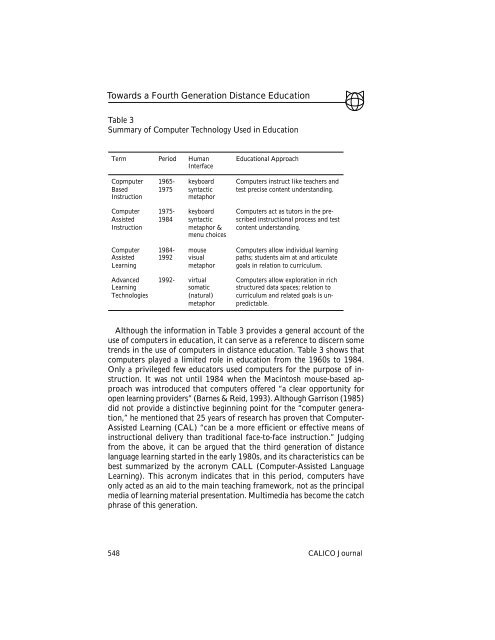Download this PDF file - Software @ SFU Library
Download this PDF file - Software @ SFU Library
Download this PDF file - Software @ SFU Library
You also want an ePaper? Increase the reach of your titles
YUMPU automatically turns print PDFs into web optimized ePapers that Google loves.
Towards a Fourth Generation Distance Education<br />
Table 3<br />
Summary of Computer Technology Used in Education<br />
Term Period Human<br />
Interface<br />
Copmputer<br />
Based<br />
Instruction<br />
Computer<br />
Assisted<br />
Instruction<br />
Computer<br />
Assisted<br />
Learning<br />
Advanced<br />
Learning<br />
Technologies<br />
1965-<br />
1975<br />
1975-<br />
1984<br />
1984-<br />
1992<br />
keyboard<br />
syntactic<br />
metaphor<br />
keyboard<br />
syntactic<br />
metaphor &<br />
menu choices<br />
mouse<br />
visual<br />
metaphor<br />
1992- virtual<br />
somatic<br />
(natural)<br />
metaphor<br />
Educational Approach<br />
Computers instruct like teachers and<br />
test precise content understanding.<br />
Computers act as tutors in the prescribed<br />
instructional process and test<br />
content understanding.<br />
Computers allow individual learning<br />
paths; students aim at and articulate<br />
goals in relation to curriculum.<br />
Computers allow exploration in rich<br />
structured data spaces; relation to<br />
curriculum and related goals is unpredictable.<br />
Although the information in Table 3 provides a general account of the<br />
use of computers in education, it can serve as a reference to discern some<br />
trends in the use of computers in distance education. Table 3 shows that<br />
computers played a limited role in education from the 1960s to 1984.<br />
Only a privileged few educators used computers for the purpose of instruction.<br />
It was not until 1984 when the Macintosh mouse-based approach<br />
was introduced that computers offered “a clear opportunity for<br />
open learning providers” (Barnes & Reid, 1993). Although Garrison (1985)<br />
did not provide a distinctive beginning point for the “computer generation,”<br />
he mentioned that 25 years of research has proven that Computer-<br />
Assisted Learning (CAL) “can be a more efficient or effective means of<br />
instructional delivery than traditional face-to-face instruction.” Judging<br />
from the above, it can be argued that the third generation of distance<br />
language learning started in the early 1980s, and its characteristics can be<br />
best summarized by the acronym CALL (Computer-Assisted Language<br />
Learning). This acronym indicates that in <strong>this</strong> period, computers have<br />
only acted as an aid to the main teaching framework, not as the principal<br />
media of learning material presentation. Multimedia has become the catch<br />
phrase of <strong>this</strong> generation.<br />
548 CALICO Journal
















